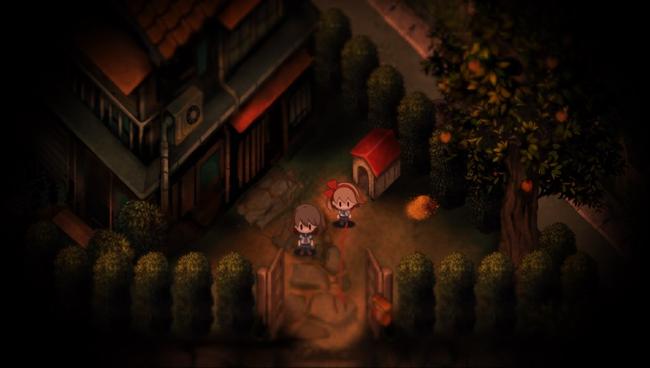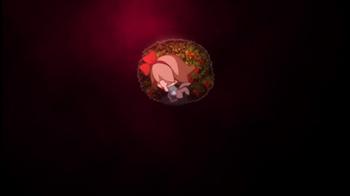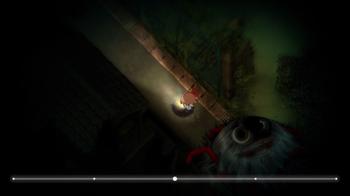
Yomawari: Night Alone Review
My face turned completely pale. I wasn’t even two minutes into the game and I witnessed one of the most shocking moments I have seen in a long time. I cursed under my breath as I silently continued on; my expectations thrown out the window as I was captivated with what I may have to deal with next.
This is the type of experience Yomawari: Night Alone delivers shortly into its main story. The nameless protagonist, a young girl, takes her dog Poro for a walk one night. However, the girl suddenly loses sight of him. Soon after, she comes across her older sister in the nearby park, who promises to help find their companion. She goes off in search of Poro and tells the young girl to close her eyes and hide behind a nearby bush. But after a few hours of waiting, the innocent girl notices she is once again all alone.
After finding a flashlight lying near the ground, the girl soon discovers the town has completely changed. Spirits inspired by Japanese urban legends now roam the streets. Some are plainly invisible, with others remaining hidden. For them, only the sounds of their frightening screams and the girl’s racing heartbeat can suggest their approximate location.

The girl must search around the empty town in the middle of the night to try to locate her missing sister and Poro. Along the way, she will also learn and encounter the fate of some of the other residents of the town and nearby school (which opens up some very interesting side quests).
Aside from some street lamps, the primary source of light is your flashlight. It is mostly used to locate hidden spirits and can be directed 180 degrees from where you are facing using the right analog stick on the Vita.
Other than a few exceptions like causing a spirit to appear, the flashlight can’t be used as a stalling tactic. The spirits will still continue chase after the girl as she tries to run with a limited amount of stamina. In those situations, the player must hide behind the meager number of bushes and signs.
Shrines are used as checkpoints and fast travel points, which helps given the open world nature of the game. Their quick save function can only be used if you have gathered one of the coins scattered around the map, of which only a small number are available.
This is where the survival horror mechanics come into play. Due to the lack of resources, the player will have to decide how far they want to go before saving at a shrine. The only other items are stones and torches you can throw on the ground to distract enemies.
Unfortunately, this is where Yomawari runs into some of the same problems that Firefly Diary suffered from. Though it provides an incredible experience filled with enjoyable gameplay moments, as soon as the young girl dies, you are suddenly thrown back to the last checkpoint.
This can completely disrupt the flow of the game and at times be frustrating to deal with, especially with the checkpoints being spread out so far. Despite this, the game at least controls significantly better than Firefly Diary.
Towards the end of the story I was attempting to exercise patience. I was stuck trying to put up with the systems of the game while trying to remain engrossed with the plot. I wouldn’t say it caused me to give up on the game completely, but I was trying my best to withstand it.
On the other hand, I quickly fell in love with the exceptional visual and sound design aesthetics found in Yomawari. I am a huge fan of 2D sprites, especially well-animated ones. I could clearly tell how frightened the young girl was, running around all by herself. The spirits themselves range from disturbing to outright horrifying.
There is almost no music to speak of. Its effective ambience of the girl’s thudding footsteps and the gruesome sounds of the spirits delivered an amazing atmosphere. It did a great job in pulling me into what was happening and never letting go until I stopped playing. I highly recommend playing the game entirely with headphones on as it really adds a lot to the adventure.
The other downside this game faces is just how short the game actually is. And since a good number of the enemies are easily avoidable, I didn’t have to experiment with the consumable items unless I had to in order to advance. Even then most of the collectibles you find serve no purpose but to give the world flavor - not that I'm complaining.
Plus, the story became a little hard to follow as I near the climax with several different events happening at in short succession. In a way it kept me guessing which may have been the entire purpose. It wasn’t until the game was over that I understood what truly happened.
But I still really enjoyed the concept of the story. It felt like I could relate to what the young girl was going through. Here she is, completely abandoned in the night, surrounded by life-threatening danger. She shows a remarkable level of courage and determination for someone her age. It’s not a matter of whether she should find her sister and dog - she must find them.
It reminded me a lot about the story the director of Yomawari, Yu Mizokami, told us during Anime Expo. She talked about how she used to work late into the night on Disgaea 5. Since she lives way out in the Japanese countryside, she would have to drive on these dirt roads where there was little light to speak of.
During those moments she’d think of the scary things that may appear while she was driving, which in turn inspired the composition of the game. It’s something I’m sure a lot of us can empathize with.
It was certainly something I thought about a lot playing through the game. I still deal with a slight fear of the darkness. Just thinking about these spirits leaping out from behind me makes me nervous (though I guess spirits aren’t the only thing I should be afraid of living around Los Angeles).
I don’t think I’ll ever forget the bone-chilling reaction I had in the opening moments of Yomawari: Night Alone. It was the perfect way to grab someone’s attention and immerse them into the tone of the game.
If it wasn’t for the hindrance of the mechanics and the length of the game, we’d be looking at one of the best games of the year. However, I would still highly recommend it for anyone looking for a fascinating experience deserving of a sequel.

